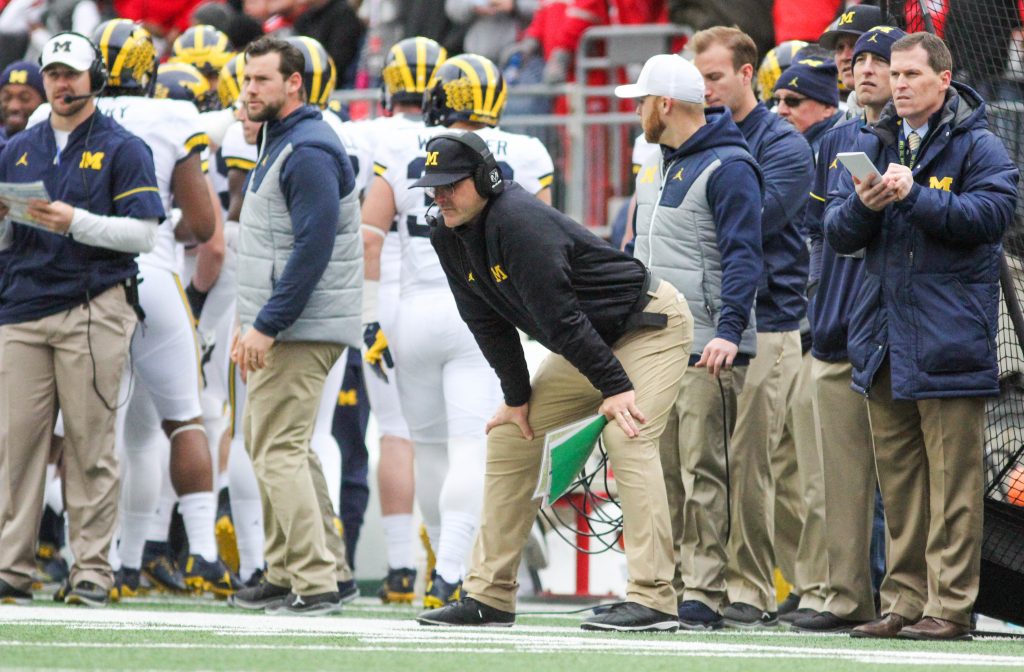
Michigan football coach Jim Harbaugh looks on after the last touchdown during the game on Nov. 26 at Ohio Stadium. The Buckeyes won 30-27. Credit: Mason Swires | Assistant Photo Editor
Without question, Jim Harbaugh has repaired the weakened Michigan football program that Brady Hoke left behind.
But nearing the end of his third season, carrying an 8-3 record and still without a top-two finish in the Big Ten East, Harbaugh is facing questions about the quality of his tenure beyond his golden sound bites.
Yes, Michigan’s program is better than where Hoke left it. But under Harbaugh, the Wolverines are 1-4 against Big Ten rivals Ohio State and Michigan State, and with a tough game against the Buckeyes set for Saturday, plus a bowl game, they could reasonably finish 8-5.
Is that what Harbaugh was hired to do? No — which means some questions about Harbaugh’s tenure are fair. Still, Harbaugh deserves more patience, even if his eccentric character, illustrious arsenal of metaphors and past success, both at Stanford and in the NFL, have lent him near-mythical status.
“I wasn’t consciously doing anything to be on the radar, just coaching the football team,” Harbaugh told reporters Monday at his weekly press conference.
The first thing to consider when evaluating Michigan since Harbaugh has been coaching the football team is what has happened around the Big Ten. Ohio State, under Urban Meyer, has been exceptional and reasserted itself as college football royalty.
With its necessary NCAA sanctions expired, Penn State has re-established itself on the field, particularly the past two seasons. One of the Wolverines’ three losses this fall came on the road against the then-No. 2 Nittany Lions. Should that be hung over Harbaugh’s head?
Since 2010, Michigan State, long a bastion of mediocrity, has refashioned itself as a top program in the conference — it has won more Big Ten titles than any team over the past seven seasons — and nationally. (To be fair, the Spartans were awful in 2016, but they had won at least 11 games in five of their previous six seasons and appear to have returned to playing actual football).
And this is just in the Wolverines’ division, the Big Ten East. There’s also Wisconsin turning in 10-plus-win seasons left and right and Iowa being Iowa. Harbaugh’s seven conference losses have been against these five teams. Indeed, to be considered top-notch you have to beat other top-notch teams, but no one can ignore the quality he’s competing against in the Big Ten. It’s like faulting the Beach Boys because they aren’t the Beatles or the Rolling Stones.
The second thing to consider is Harbaugh has yet to completely have his hand-picked quarterback lead the offense. At Stanford, once Harbaugh’s prized recruit Andrew Luck took the reigns, the Cardinal went from 4-8 and 5-7 without him to 8-5 and 12-1.
In Harbaugh’s first season at Michigan, following four seasons coaching the San Francisco 49ers, he had Iowa graduate transfer Jake Rudock under center. Rudock was surprisingly good, leading the Wolverines to 9-3 regular season and a Citrus Bowl victory against then-No. 19 Florida, but no one was going to confuse him with Luck or J.T. Barrett or former Michigan State quarterback Connor Cook.
Last year, Harbaugh had then-redshirt sophomore Wilton Speight see the bulk of the action under center. Speight, a Hoke recruit, was fine — completing 61.6 percent of his passes for 2,538 yards and 18 touchdowns in 12 starts. While Speight also isn’t Luck or Barrett or Cook, the Wolverines looked like a championship-caliber team that throttled eventual Big Ten champion Penn State 49-10 before inexcusably losing three of their last four.
This fall, Speight, who was one of Michigan’s mere five returning starters, has been sidelined due to injury since Sept. 23, leaving Harbaugh stuck with redshirt senior John O’Korn, a Houston transfer who objectively is not that good, and redshirt freshman Brandon Peters.
Behind defensive coordinator Don Brown, the Wolverines’ defense is still No. 3 in the country, but the defense can only do so much when you’re throwing O’Korn out there against Penn State and an inexperienced Peters against undefeated Wisconsin on the road. Peters left the game against the Badgers with a concussion and is status for Saturday is uncertain.
Harbaugh, a former Michigan quarterback himself, needs a quality signal-caller to lead his offense. He had it with Luck, mostly with Rudock, and sometimes with Speight in 2016.
Next fall, with two of his talented recruits — Peters, a former four-star prospect who Harbaugh said has similarities to Luck, and fellow four-star Dylan McCaffrey, who is currently redshirting — presumably joining Speight in a three-way quarterback battle, Harbaugh will be in a better position to have the caliber player he needs under center.
Then, the clock really starts ticking for Harbaugh. The lofty expectations that followed him to Ann Arbor in 2015 can start to be rigorously applied. It doesn’t mean Saturday’s game is meaningless — it’s still a huge rivalry — but it shouldn’t be used as a further indictment of Harbaugh since the Wolverines have two dinged-up quarterbacks and little to play for in the big picture. It also doesn’t mean Harbaugh is above criticism the past three seasons.
But because of the quality of Big Ten competition and the quality of his quarterbacks, any of Harbaugh’s shortcomings have lacked context and haven’t all been deserved.
At the least, the past three seasons have been good for sound bites.


